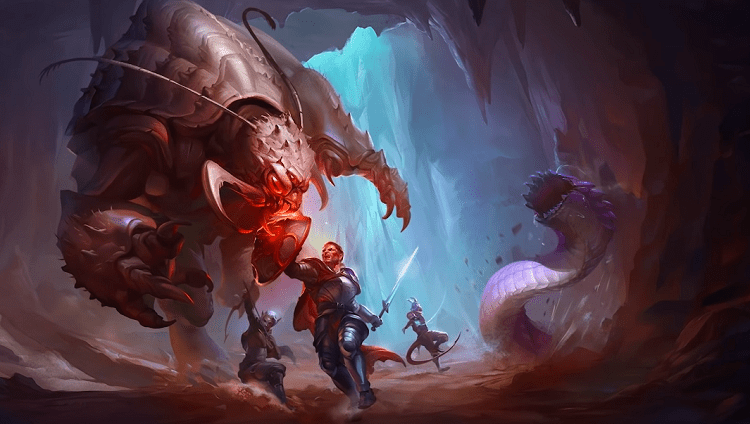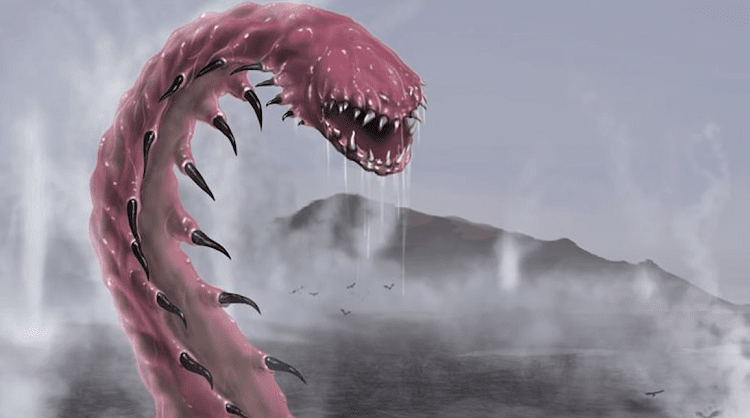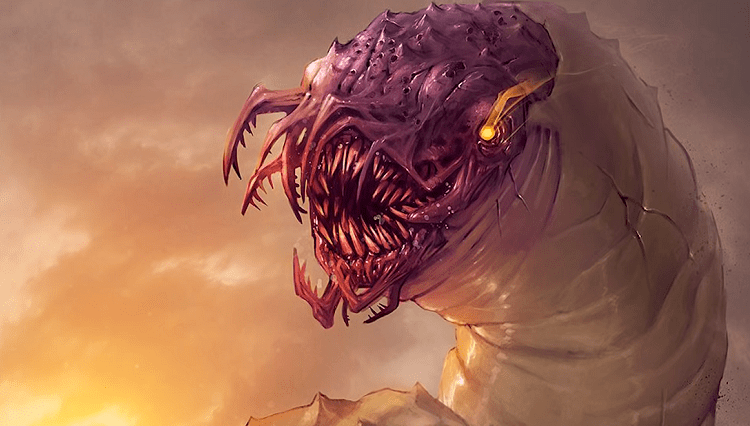Damage is significant in any combat-centric game, and D&D is no exception. There are D&D classes that hit many times, classes that shoot massive area of effect spells, and even those that target one boss and deal enormous damage in a singular hit.
Some notable builds revolve around critical hits, others about hitting thirteen times in one round. There are many ways to achieve significant damage in a single round, and this guide shows one.
While I cannot say that I have tried everything that D&D has to offer, I can say that I have tried everything the base D&D game has. From subclasses and D&D races to magical and mundane items. As a DM, I have spent countless hours reading up on how things work and how interactions play out in the game.
Let’s kick of our Purple Worm 5e guide and discuss one of those enemies that can give you an item that can compete with a few magical items. I’m talking about the Rogue’s second best friend: Purple Worm Poison.
What is a Purple Worm
Purple Worms are gargantuan-sized creatures. They are shaped like a worm and tend to burrow to move around. They are so powerful that they can burrow through solid rock with little difficulty.
As the name suggests, these creatures are known for the purple-colored chitin that covers their hide and the poison its stinger can inject into their prey.
These creatures are CR 15, meaning an average party of four level 15 adventurers would find this a doable challenge. They have a poisonous stinger for a tail and are large enough to swallow a creature whole. They are strong and occasionally eat and run, so make sure to take it out before it makes you take out.
Appearance

It’s an 80-foot long (24 meters) and 5-foot wide worm covered in sand-colored spikes and purple chitin. It weighs around 40,000 pounds(18,000~ KG) and moves surprisingly fast for a creature of its size.
They are loosely inspired by Frank Herbert’s Dune, similar to the large sandworms found in his novel. It just turned purple and was covered in spikes and poison.
Being a massive earthworm, it has no eyes and senses the vibrations in the earth to locate its prey. It has a giant gaping maw that it uses to consume its victims whole by dashing towards them and swallowing them up along the way.
In combat, they tend to curl and coil around themselves so that they can use their sharp teeth and poisonous tail in conjunction with each other to strike at opponents.
Locations
Purple Worms live underground. While they did originate from the Underdark, due to a lack of food, they have migrated out of their tunnels and into the overworld. This is why the Underdark is now a series of tunnels connecting various caves and caverns.
In the overworld, they still stay underground but find their homes beneath the desert or inside mountains. In older editions, they used to be able to swim and had an underwater variant, but now they safely live on land and do not harass the sailors anymore.
So if you feel the earth rumble beneath you, make sure you don’t move; otherwise, the Purple Worm will get you.
Defining Features

From asking my various players who have encountered this creature, they divided how they remember the worm into two general categories. Either as Loot or as an epic encounter.
As a boss in the desert, my players have stated the sheer terror they felt being swallowed by this monster. It does massive damage on a successful dine and dash, and the worse part is that if it tunnels, it can get away from the party, essentially kidnapping one of them for a take-out dinner.
They remember it being tanky and an all-around nuisance to try and fight as it kept burrowing and striking from a hidden position.
As Loot, the one that is most remembered and will be talked about later is the poison that you can extract from it. The other thing I allowed my players to take from it was its chitin, which could be used later to create magical +2 armors.
Of course, crafting in D&D is homebrew, so if you are running a true-to-the-book game, then the poison will have to do.
Attacks
For a creature of this size, it’s apparent that it uses its strength over its Dexterity. As such, it only has two attacks and can make one of each attack every turn.
First is its Bite attack, a single target attack with a decent hit chance of a +9. What makes this attack devastating is not the 3d8+9 damage it deals with but rather its chance to swallow a creature.
If it targets something Large or smaller, it can force a DC 19 Dexterity saving throw or be swallowed whole. That is nearly a death sentence for magic casters, as their Dexterity is usually relatively low.
While swallowed, the creature is blinded, restrained, and taking guaranteed 6d6 acid damage a turn. It can only regurgitate them if the worm takes 30 damage or more in a single turn and fails the following DC 21 Constitution check afterward.
So if you get eaten by this thing, you’ll melt in its stomach acids until someone gets you out.
Its second attack is its tail stinger, a 3d6 piercing attack that forces a DC 19 Constitution saving throw, or they take 12d6 poison damage. On a success, they take half the poison damage.
That’s around 45 damage on average, so if it skewers you and then bites you, you might have to roll a new character due to how much damage the total of two attacks does.
Strengths

Due to its massive size Purple Worms are incredibly strong, so its Strength and Constitution scores are through the roof. It has a decently high AC with its thick chitin and an enormous health pool. It’s incredibly tanky as a singular enemy and can make for an exciting boss encounter if met in the desert or underground.
If met beneath the earth, a Purple Worms Tremorsense and Blindsense aid it far more than any normal vision can. Pair that with its surprisingly high movement speed, and it can weave in and out of its tunnels in a flash.
Weaknesses
With its strengths comes its weaknesses. Purple Worms have no ranged attack, so as long as you are around 100 feet in the air, they cannot do anything to hurt you.
While its Strength and Constitution are high, its other stats are lacking, especially its mental stats, so it is weak to spells that take advantage of those low stats. Charms, Holds, and illusions should be able to keep it at bay.
Due to it having no eyes, it must rely on the vibrations in the earth to sense its opponent; levitation, flight, or other similar effects render you practically invisible to this creature.
You may also prepare for its poison attack; resistance or immunity should be able to keep you healthy after a few blows.
Purple Worm Poison
This is an Injury type poison that forces a DC 19 Constitution saving throw. On a fail, they take 12d6 (42) poison damage; they take half as much on a successful save.
How Does Poison Work

There are four kinds of poisons in D&D: Contact, Ingested, Inhaled, and Injury. Each one has a different way of applying the poison to a target. You don’t need a poisoner’s kit to use the poisons, but to create them. Aside from these, there is also the Poisoned condition and the poison damage type.
In reverse order, the poison damage type comes from venomous creatures or spells that do poison damage. An example would be the Green Dragon or the spell Cloudkill.
The Poisoned condition usually happens after being afflicted by poisons or off of specific monster attacks. This makes it so the afflicted must roll their attacks and ability checks with disadvantages. There is no damage over time; it makes the creature less accurate.
Lastly, let’s break down the poison item.
Contact
Contact poison has to be put on an object and touched by the skin for it to be effective. It is usually thick and salve-like as it retains its potency until it is washed away or used up.
A few examples of contact poisons are Crawler Mucus and Oil of taggit.
So you generally want to coat things you know your target will touch, such as clothing or handles. Hopefully, no one else touches it before your target; otherwise, you’ll poison them.
Ingested
These kinds of poisons need the full dosage to be eaten for it to have an effect, however, the rules state that a half dosage may do half the intended effect.
Normally they are hidden in food or drink but sometimes they can be disguised as medicine if you can convince the victim to take it. Normally their descriptions have a scent or a flavor attached to it to further assist in a player’s attempt to hide the after-effects.
Examples of ingested poisons are Assassin’s blood or Midnight tears.
These are harder to use but usually carry debilitating effects like sleep or paralysis.
Inhaled
These are powder-like substances or gaseous in form. Merely breathing it in allows for its effects to take place. Holding your breath does not work against this type of poison as they enter through your open membranes and other sensitive areas of the body.
There is a special ruling to how the gas works, as a single dose can only take up a 5-foot cube. However, if multiple doses are released into a room, then it would eventually fill up the room with poison.
One of the more crazy types of poisons is difficult to avoid even with knowledge of it. Unless you are immune or resistant to this type of poison, nothing stops an enemy from just throwing this in your face and watching you suffer.
On the other hand, if you can debilitate the enemy’s Constitution saving throw, this is an impactful boon to have on your side.
Injury

These are the kinds of poisons used in combat; you do not need to be a rogue to use them either. Just apply it before or during combat to gain its effects. Know that the poison only lasts one hit, so the moment you land a hit, you need to either keep going or reapply the poison.
They only affect weapons and items with the piercing or slashing damage type, and only deliver the poison once the damage has been dealt in those properties. You could use this on a bear trap if you wanted to, as it does one point of piercing damage, or your sword which does 1d8 points of slashing.
It’s best for burst damage or trying to take down a boss as fast as possible. It is up to you to consider whether it is worth the cost.
A few examples of this kind of poison are the Purple Worm poison or Drow poison.
Comparison to Other Poisons
Purple Worm poison is the most expensive poison of all the named and available poisons listed in the DMG. The question is: is it worth the price?
Let’s compare its effects to a few other injury-based poisons, then compare it to the other types of poisons.
Purple Worm poison is 2000GP and does 12d6 poison damage on the fail of a DC 19 Constitution saving throw.
Serpent venom is the cheapest injury-based poison, is 200GP, and does 3d6 poison damage on the fail of a DC 11 Constitution saving throw.
Basic poison is 100GP and does 1d4 on a fail of a DC 10 Constitution saving throw for one minute and does not get removed upon dealing damage.
Here is the quick math assuming that the creature fails the Constitution saving throw and they take maximum damage.
- Purple Worm poison does 72
- Serpent Venom does 18
- Basic poison does 40 assuming they attack for 1 minute straight.
So if you are looking only at the damage, then the basic poison is the most cost effective. Scaling the amount up to 2000 Gp would mean that the Basic poison does 800 damage. Serpent venom would do 180.
However you also must take into account the DC of the Constitution saving throw. If we assume a creature has a +2 to Constitution saving throws that would mean that the odds of him succeeding this save are as follows.
- Purple Worm poison would need to roll 17 up to succeed or a 20% chance of success.
- Serpent Venom needs a 9 up to succeed or a 55% chance of success.
- Basic poison needs a 8 up to succeed or a 65% chance of success.
As you can see, you are paying for the likelihood of the creature failing on the poison save and assuming late-game creatures who have massive constitution scores such as the Purple Worm for example. Those creatures would instantly succeed on the weaker saving throws as their bonus is flat out higher than the DC.
How to Acquire

You can either purchase it or harvest it yourself. Here are the rulings behind how to accomplish that.
Purchasing Poison
While D&D might be lax on certain rulings, they are very concrete about the legality of this transaction. That is to say that this is very illegal.
So certain cities or kingdoms may prohibit possessing or using poison, however a black-market, the local thieves guild or even a sketchy plague doctor may have a stash kept away.
Characters who have criminal contacts might be able to get in touch to acquire the poison. Other characters would have to go through many hoops, and probably expensive bribes to be able to buy poison.
That is to say that you need to have established with your DM beforehand that you have these connections. Otherwise, you’ll need to hope you know the way to the black market or thieves guild.
Not all Rogues may have this connection, as this is something to establish in a character’s backstory. However, the knowledge of thieves’ cant may help locate places to purchase such illegal wares.
For the DMs out there, you can add additional barriers for entry, such as an entrance fee or bribery, as your players may be a band of strangers wandering into town. You could even remove the black market if the village is small enough.
Harvesting Poison
Any one can try to harvest poison from a creature so long as the creature itself is poisonous. The creature however must be dead or incapacitated, and the process takes 1d6 minutes.
After the minutes pass, the character must succeed on a DC20 Intelligence (Nature) check that can be substituted with a poisoner’s kit check if they have proficiency.
On a success they harvest one single dose of the poison, on a failure you do not. On a failure of five or more, they hurt themselves on the creature allowing the poison to seep into their systems, they are then subjected to the effects of the poison.
Doing this eliminates the costs and middle man entirely; however, you take on all the risk of hunting down a creature, defeating it, and rolling to harvest the poison.
DMs, know that the DMG does not state how many vials of poison a creature can produce. So have a general number in mind and be ready for your players to try and extract everything they can from it.
Players, go wild and hunt a creature to extinction for that poison; do not try to inflate the economy with poison. So keep vials on hand and be ready for your DM to tell you that there’s nothing left.
Crafting Poison
This is mentioned in the DMG, but the crafting system in D&D is not fleshed out well, so here is my take on how to create poison.
For DMs out there:
Certain poisons are made from plants and natural minerals, so If you are willing to put in the effort, you can figure out a recipe to create poison. Perhaps with a nature check, you can tell your players what plants are poisonous. You can also say that their proficiency with the poisoner’s tools allows them to identify the ingredients to make a poison.
For players:
If your DM does not allow crafting in the game, please let it be. There are very few 5th edition rules on crafting, so it’s as if we are creating rules from scratch, and it may end up breaking the game. Thank you.
Using Poison

So this all depends on what kind of poison you are using. In this case, the Purple Worm poison requires an action to coat a weapon or three pieces of ammunition. You can prepare this before combat because this poison is so potent it will only be removed by washing it off or delivering it through a wound.
If you look at Basic Poison, they can do the same coating, but only for one minute, as afterward, the poison evaporates.
For the other types of poisons, it is still an action, but rather than coating it, you have to sneak it into food (using a Dexterity or Slight of Hand check) or throw it/blow it into your enemy’s face.
While later on in the game, poison becomes slightly more of a gamble, as higher leveled monsters usually have resistance or immunity to poison,. It still functions quite well defeating the minions of said boss creature or maybe even the boss itself.
If not in a fight then it could be used in a social interaction. Perhaps you need to assassinate a certain official without any bloodshed, so slipping him some hemlock in his midnight tea might do the trick.
FAQs
Question: Can You Create Purple Worm Poison?
Answer: No, you cannot. This poison can only be harvested or bought from someone who has gathered it. Abilities and spells that create items usually have the caveat of needing the raw materials, being limited to specific materials, or having a gold cost limit.
In those cases, this poison still cannot be created as it is too expensive and naturally occurs due to Purple Worms.
Question: How Do You Harvest Poison?
Answer: A character can attempt to harvest poison by making a DC 20 Intelligence (Nature) check on an incapacitated or dead poisonous creature. You can substitute the Nature check with an intelligence check made with the poisoner’s kit if the character does not have proficiency in Nature.
The harvesting takes 1d6 minutes. The character harvests enough poison for a single dose on a successful check. On a failed check, the character is unable to extract any poison at all, and if they fail by five or more, they accidentally prick their finger and suffer the effects of the poison.
Question: How Many Arrows Can I Coat in One 2000GP Worth of Purple Worm Poison?
Answer: Up to three pieces of ammunition. This is based on the ruling on how much ammunition a single basic poison vial can coat.
While the Purple Worm poison is about twenty times more expensive than the basic, remember that it does around 17 times more damage on average and has a much higher DC to pass. This is where the expense comes in.
Poison’s Great
Purple Worms are a formidable enemy to go up against, but their real rewards lie in the poison you can harvest from them.
All in all, using poison is an excellent investment from early to late game. As you level up, so do your rewards; in turn, you spend that on further investment into higher-level poisons.
Usually, you will find yourself with an abundance of gold, so instead of buying insane amounts of basic healing potions, why not power up your next attack with poison? Of course, you would have to be a class that attacks, so magic casters, good luck.
- Prestige Classes 5e Guide - September 20, 2022
- Rod of the Pact Keeper 5e Guide - September 15, 2022
- Sanctuary 5e Guide - September 14, 2022

